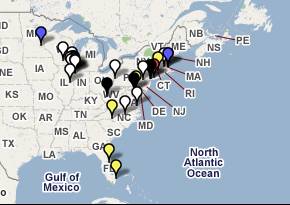Hapless Sun-Times May Be Next Big Downturn Victim

Meanwhile, the Chicago Sun-Times Media Group (STMG) reported a dismal fourth quarter 2007 net loss of $59.1 million, up from $34.6 million a year earlier. Editor & Publisher notes that “STMG, which publishes about 100 dailies and non-dailies in the Chicago market, is in the midst of a study of ‘strategic alternatives,’ including a sale of all or part of the company.”And to highlight how bad things are, “STMG launched a plan to reduce operating costs by $50 million by June 30, 2008. Among the measures the company undertook was outsourcing distribution to the rival Chicago Tribune, outsourcing ad production, newsroom and management layoffs, and folding some newspapers.” Can you imagine outsourcing distribution to your competitor?
Profitless in Seattle
Wanna buy a newspaper? Or three of them, actually. The Seattle Times. Co. is trying to unwind its ill-advised 1998 decision to go into debt to buy three newspapers in Maine. Apparently, the purchase was homage to the paper’s founder, who hailed from the Pine Tree State. However, the cash-strapped company can no longer afford such folly and is looking to dump the Portland Press Herald, Waterville Morning Sentinel and Kennebec Journal. There’s even talk that Portland’s newspaper union might buy the local rag. Perhaps that’d be a way to restore the 27 jobs the paper recently cut.
Dow Jones Surveys the Damage
Regular NDW readers won’t find much new in this Dow Jones story about the perilous state of the U.S. newspaper industry, but it is a good wrap-up of recent events. It’s generous to the industry in recounting why newspapers didn’t invest more aggressively online a few years ago. Quoting:
“For one, many newspapers were scared away from online ventures when the dot- com boom turned to a bust in 2000. In order to fully nip online competition in the bud, however, newspapers would have needed to invest heavily in burgeoning Web ventures before those entities got too expensive. For many newspapers, that kind of investment was not within their means.”
Not within their means. That’s like driving a car on bald tires because new ones are not within your means. Newspapers have had gross profit margins of more than 20% for decades. There were plenty of “means” to invest if owners had simply seen the bullet train that was heading at them. The post-bubble period was the best time in a decade to buy into the Internet. So why didn’t any newspaper companies do that?
The best quote in the story comes from McClatchy CEO Gary Pruitt, who told a December conference that a “significant portion” of the current troubles the industry faces are “cyclical.” Right. So is global warming.
Envisioning the Future of Journalism
The Editors Weblog interviews Jim Brady, Executive Editor of Washingtonpost.com, who provides sensible insight on the future of journalism. Newspapers aren’t going away, he says, but many smaller papers are finding that the economies of scale of online publishing make it a more sensible route that newsprint. Journalism itself will also evolve to include more reader interaction, with readers doing more of the legwork. “Iif journalists allow readers, not to investigate for them, but to help them flag and acquire easily accessible information, it makes investigative journalism easier to do than it was fifteen years ago, when the journalists had to make dozens of phone calls and go down to the public library.”
Online Media Baron’s Advice: Blow It All Up
Billionaire entrepeneur and former AOL top executive Ted Leonsis has a 10-point plan to rescue the newspaper business. It basically comes down to blowing up the existing model, going entirely online and distributing through every available channel. Oh, and search-optimizing. Veteran journalists will love this suggestion:”Get rid of senior editors. Turn them into algorithmic managers…Knowing statistically what content gets the best click through across all media is a key deliverable. Newspapers need math majors running big swaths of the organization…There are too many English majors in key positions.”
Milestone Award for New-Media Publisher
 A landmark event in online journalism occurred in late February, when Talking Points Memo was awarded a George Polk Award for its coverage of the firing of eight United States attorneys. This New York Times account points to the difference between the new breed of online reporting and traditional print journalism. Chief among them is the involvement of readers in the process. “There are thousands who have contributed some information over the last year,†the paper quotes Talking Point’s Joshua Micah Marshall as saying. Marshall has even been known to give “assignments” to his readers, asking them to comb through official documents. His journalism also mixes original reporting with generous links to other information online. It’s very Wikipedia-like. And it’s working. The reader- and advertising-funded site gets about 400,000 page views a day and has about 750,000 unique visitors a month.
A landmark event in online journalism occurred in late February, when Talking Points Memo was awarded a George Polk Award for its coverage of the firing of eight United States attorneys. This New York Times account points to the difference between the new breed of online reporting and traditional print journalism. Chief among them is the involvement of readers in the process. “There are thousands who have contributed some information over the last year,†the paper quotes Talking Point’s Joshua Micah Marshall as saying. Marshall has even been known to give “assignments” to his readers, asking them to comb through official documents. His journalism also mixes original reporting with generous links to other information online. It’s very Wikipedia-like. And it’s working. The reader- and advertising-funded site gets about 400,000 page views a day and has about 750,000 unique visitors a month.
 Billionaire sports fan Mark Cuban
Billionaire sports fan Mark Cuban 


